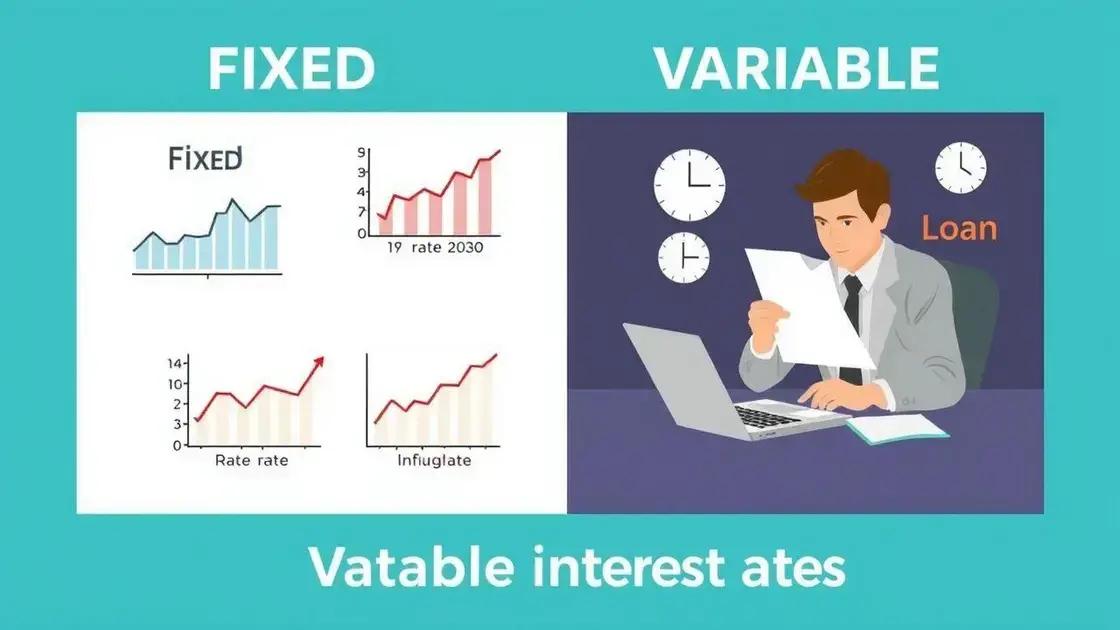Interest rates: what you need to know for financial success

Anúncios
Interest rates can be fixed, remaining constant throughout a loan term, or variable, changing based on market conditions, impacting loan payments and investment returns.
Interest rates play a crucial role in our financial lives, influencing everything from loans to savings. Have you ever considered what small changes in these rates can mean for your budget? Let’s delve into this important topic.
Anúncios
Understanding interest rates: basic concepts
Understanding interest rates is essential for making informed financial decisions. Let’s explore the basic concepts surrounding these rates and why they matter.
What are interest rates?
Interest rates represent the cost of borrowing money or the return on savings. When you take out a loan, you pay the lender interest, which is usually expressed as a percentage of the principal amount. Conversely, when you deposit money in a savings account, the bank pays you interest on your balance.
Anúncios
Types of interest rates
There are two main types of interest rates: fixed and variable.
- Fixed interest rates: These rates remain constant throughout the life of the loan.
- Variable interest rates: These rates can change based on market conditions.
- Annual Percentage Rate (APR): This is a broader measure that includes the interest rate plus other fees associated with a loan.
Knowing the difference helps you evaluate your options wisely. For example, a fixed rate might be favorable when rates are low, while a variable rate might be better if rates are expected to decrease.
The impact of interest rates on the economy
Interest rates play a crucial role in the economy. When they are low, borrowing becomes cheaper, encouraging spending and investment. Higher rates can slow economic growth as they increase borrowing costs. This relationship is a fundamental aspect of monetary policy.
Understanding how interest rates function allows you to make smarter choices regarding loans and investments. By keeping an eye on trends, you can potentially capitalize on favorable conditions.
How interest rates affect loans and mortgages
Understanding how interest rates affect loans and mortgages is crucial for anyone looking to borrow money. Whether you’re buying a home or financing a car, these rates can significantly impact your payments.
Direct impact on monthly payments
When interest rates rise, your monthly payments can increase. This happens because lenders charge more to borrow money. A small increase in the interest rate can lead to a substantial rise in your monthly expenses. For instance, on a $200,000 mortgage, a mere 1% increase in the rate could raise your payment by several hundred dollars.
Types of loans affected
Different types of loans are impacted by interest rates in various ways:
- Fixed-rate mortgages: These loans have a constant rate throughout the loan term. If rates rise after you’ve locked in your rate, you benefit.
- Adjustable-rate mortgages (ARMs): These loans have rates that may change over time. When general interest rates increase, so do the payments for these loans.
- Personal loans: Higher rates directly affect the monthly payments and total repayment amount.
Keeping an eye on interest rates not only helps borrowers prepare for future expenses but also allows them to make smarter financial choices. For example, refinancing at a lower rate can save significant amounts in the long run, especially with a long-term loan.
The effect on borrowing behavior
Higher interest rates can discourage borrowing. This slowdown in loans may affect consumer spending, which is critical for economic growth. On the other hand, when rates drop, more people are inclined to take out loans, stimulating economic activity.
Overall, understanding how interest rates work gives consumers a better grasp of their financial situations and the choices they can make regarding loans and mortgages.
The role of central banks in setting rates
The role of central banks in setting interest rates is vital for economic stability. These institutions are responsible for regulating monetary policy, which influences the overall economy.
Understanding central banks
Central banks control the supply of money and interest rates in a country. By doing so, they aim to promote economic growth and stability. The decisions made by these banks affect inflation, employment, and the overall financial system.
How do central banks set interest rates?
Central banks often use tools like the federal funds rate to influence borrowing costs. When they lower this rate, borrowing becomes cheaper, encouraging spending and investment.
- Open market operations: Buying and selling government securities to influence liquidity in the economy.
- Discount rate: The interest rate charged to commercial banks for loans from the central bank.
- Reserve requirements: The amount of funds that banks must hold in reserve, impacting how much they can lend.
Changes in these rates can have a ripple effect across the economy, affecting everything from home loans to credit card rates. For example, if the central bank anticipates inflation, it may raise interest rates to slow down economic growth and stabilize prices.
The influence of global factors
It’s important to note that central banks also respond to global economic conditions. Factors like international trade, foreign exchange rates, and global economic health can influence their decisions. When other countries adjust their interest rates, central banks may follow suit to maintain competitive balance.
The relationship between central banks and the economy is complex. Small adjustments in interest rates can lead to significant changes in consumer behavior and overall economic activity. Understanding this dynamic helps consumers and investors make informed decisions about borrowing and investing.
Inflation and its relationship with interest rates

Inflation has a direct relationship with interest rates, influencing how much money you will pay on loans and earn on savings. Understanding this connection is essential for managing your finances.
What is inflation?
Inflation refers to the rate at which the general level of prices for goods and services rises. When inflation increases, each unit of currency buys fewer goods and services, eroding purchasing power. High inflation can lead to increased interest rates as central banks attempt to control price increases.
How do interest rates affect inflation?
When a central bank raises interest rates, borrowing becomes more expensive. This discourages spending and investment, which can help reduce inflation. Conversely, lower interest rates tend to encourage spending and investing, potentially leading to higher inflation.
- Higher rates: Less demand for goods and services reduces price pressures, slowing inflation.
- Lower rates: Increased consumer and business spending can stimulate the economy, potentially increasing inflation.
- Expectations: If people expect inflation to rise, they may demand higher wages, further pushing inflation upward.
Understanding the delicate balance between inflation and interest rates is crucial for consumers. It helps you make better decisions regarding loans and investments. For example, if inflation is expected to rise, locking in a fixed-rate mortgage can be a wise choice.
The role of monetary policy
Monetary policy plays a significant role in managing both inflation and interest rates. Central banks adjust rates based on their inflation targets. When inflation is too high, central banks may raise interest rates to cool down the economy. If inflation is too low, they might lower rates to encourage borrowing and spending.
This relationship is a fundamental aspect of economic understanding. Keeping an eye on interest rates and inflation can help individuals make informed financial choices, ensuring their investments remain sound amid changing economic conditions.
Predicting future interest rate trends
Predicting future interest rate trends is important for borrowers and investors alike. Many factors come into play when trying to forecast these rates.
Economic indicators
Several economic indicators can help predict changes in interest rates. These include inflation rates, employment data, and GDP growth. An increase in inflation often prompts central banks to raise rates to keep prices in check. Strong economic performance typically leads to higher interest rates.
- Consumer Price Index (CPI): A rise in CPI signals increased inflation, which may lead to higher interest rates.
- Unemployment rates: Low unemployment often correlates with rising demand and inflation, influencing rate hikes.
- GDP growth: Rapid GDP growth may lead to increasing interest rates as the economy heats up.
Furthermore, interest rate predictions require attention to central bank policies. Central banks, like the Federal Reserve, regularly communicate their goals regarding interest rates, including target inflation levels and employment objectives.
Market expectations
Market expectations significantly impact future interest rates. Traders in financial markets factor in central bank communications and economic data to make predictions. The bond market is a key area where investors assess future rate moves.
If investors believe that rates will rise, bond prices may drop, reflecting this expectation. This dynamic influences lenders’ decisions and can make borrowing more expensive.
Technological tools
Advancements in technology provide tools for predicting rate trends. Analysts use complex models that analyze vast amounts of data. These algorithms help identify patterns and trends that might not be visible to the naked eye. By using historical data, analysts can better understand how interest rates may behave in different economic conditions.
In conclusion, while predicting future interest rate trends is challenging, staying informed about economic indicators, central bank actions, and market expectations can provide valuable insights for making financial decisions.
Strategies to benefit from changing rates
Understanding interest rates is crucial for financial success. As rates fluctuate, there are specific strategies you can employ to make the most of these changes.
Refinancing loans
One effective strategy is to consider refinancing your loans when interest rates drop. By securing a lower rate, you can significantly reduce your monthly payments. This is beneficial for mortgages, personal loans, and student loans.
- Compare options: Research different lenders to find the best rates.
- Calculate potential savings: Use online tools to see how much you could save by refinancing.
- Consider closing costs: Ensure the savings outweigh any fees associated with refinancing.
Monitoring interest rates can help you take advantage of lower rates before they begin to rise again.
Adjusting investments
Another strategy involves adjusting your investment portfolio in response to changing rates. When interest rates rise, certain asset classes may perform better.
- Bonds: Typically, bond prices fall when rates rise. Consider shorter-term bonds to minimize risk.
- Stocks: Some sectors benefit from rising rates, such as financials. Research which stocks may thrive in a higher rate environment.
- Real estate: Higher rates could affect housing demand. Keep an eye on market trends to inform your investment decisions.
By staying informed about how interest rates impact various investments, you can make well-timed decisions to enhance your portfolio.
Utilizing savings accounts
As interest rates increase, higher yields may be available on savings accounts and CDs. Take advantage of these opportunities by shopping around for accounts that offer competitive rates. This strategy not only helps safeguard your money but also allows it to grow more effectively.
Finally, educating yourself about interest rates and remaining flexible with your financial strategies will help you navigate the ups and downs of the economic landscape. Take proactive steps to ensure you are leveraging these changes to your financial advantage.
How to adjust your investments based on interest rates
Adjusting your investments based on interest rates is essential for maximizing returns and minimizing risks. Understanding how these rates impact different asset classes can help you make informed decisions.
Monitor interest rate trends
Stay informed about current and predicted interest rates. Economic news, expert forecasts, and central bank announcements are valuable resources. Higher rates can lead to lower bond prices, while they may benefit sectors like financials and certain commodities.
Rebalance your portfolio
As interest rates change, it’s wise to review and rebalance your portfolio. Consider adjusting allocations to various asset classes:
- Bonds: When rates rise, bond prices typically fall, so you may want to reduce exposure to long-term bonds.
- Stocks: Sectors like utilities may underperform during times of rising rates, while banks might benefit.
- Real estate: Higher rates can impact mortgage approvals and housing demand, so evaluate your real estate investments accordingly.
By actively managing your investment allocations, you can potentially shield yourself from losses or even profit during rate changes.
Utilize fixed-income investments wisely
In a period of rising interest rates, consider shorter-term fixed-income investments. These typically have less interest rate risk compared to long-term bonds. Look into certificates of deposit (CDs) or savings accounts that offer competitive rates, which can be beneficial as rates rise.
Stay flexible with your investment strategy
Adapting your investment strategy to changing interest rates requires flexibility. You might consider a diversified approach that allows you to pivot based on economic conditions. This might include swapping from growth stocks to value stocks when rates rise or vice versa when rates fall.
In any case, regularly assess how interest rates influence your investment decisions, helping you to align your portfolio with current financial realities.
Understanding fixed vs variable interest rates

Understanding the differences between fixed and variable interest rates is crucial for making sound financial decisions. Each type has its unique benefits and risks, impacting loans, mortgages, and savings accounts.
What is a fixed interest rate?
A fixed interest rate remains constant for the entire term of the loan or investment. This stability provides predictability in monthly payments, making budgeting easier.
- Stability: You know exactly how much you will pay each month.
- Protection against rising rates: If interest rates increase, your rate stays the same.
- Good for long-term loans: Fixed rates are often ideal for mortgages and long-term loans.
This predictability can be comforting in a fluctuating economy, as it shields borrowers from sudden rate increases.
What is a variable interest rate?
A variable interest rate, on the other hand, can change at specified intervals. These rates are often tied to a benchmark, like a bank’s prime rate, which fluctuates based on economic conditions.
- Potential for lower initial rates: Variable rates typically start lower than fixed rates.
- Risk of increases: Payments can rise if rates go up, making budgeting less predictable.
- Ideal for short-term loans: Variable rates may be beneficial if you plan to pay off a loan quickly.
Choosing between fixed and variable rates often depends on your financial situation and goals. A fixed rate may be the safest choice for long-term loans, while a variable rate could offer flexibility for short-term financing needs.
Which one is right for you?
To determine which option is best, consider your risk tolerance and how long you plan to hold the loan or investment. If you prefer stability and predictability, a fixed interest rate might be ideal. However, if you are open to the possibility of changing payments in exchange for potentially lower initial costs, a variable interest rate could be advantageous.
Ultimately, understanding the key differences between fixed and variable interest rates will help you make more informed financial decisions.
FAQ – Frequently Asked Questions About Interest Rates
What is the difference between fixed and variable interest rates?
Fixed interest rates remain the same throughout the loan term, while variable rates can change based on market conditions.
How do interest rates affect my loans?
Interest rates determine how much you pay in interest on loans. Higher rates mean higher payments, while lower rates can save you money.
When should I consider refinancing my loan?
Consider refinancing when interest rates drop significantly lower than your current rate, which can lower your monthly payments.
Why are interest rates important for my investments?
Interest rates impact the returns on various investments, including bonds and stocks, affecting overall investment strategy and profitability.






